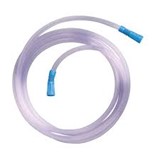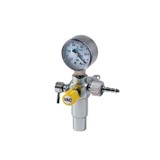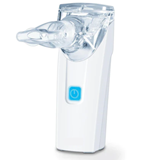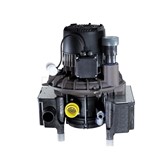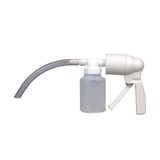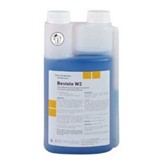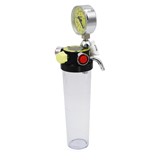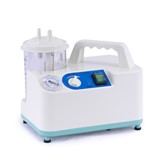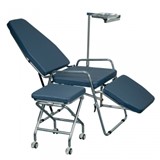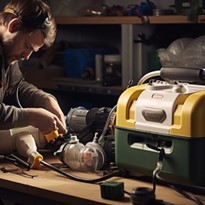Portable suction machines play a pivotal role in various medical settings, offering critical assistance in the removal of unwanted fluids and materials from the airways. This guide delves into the intricacies of purchasing these devices, providing a comprehensive overview to assist you in making an informed decision.
I. Understanding the Importance of Portable Suction Machines
A. Medical Scenarios Where Portable Suction Machines Are Crucial
- In emergency rooms: Ensuring rapid removal of obstructions from patients' airways is essential for stabilizing critical cases.
- During surgeries: Maintaining a clear surgical field is vital for the success of surgical procedures, requiring reliable suction devices.
- In home care settings: Enabling individuals with respiratory issues to manage secretions and breathe comfortably in the comfort of their homes.
B. Life-Saving Potential in Emergency Situation
- Immediate suction can prevent life-threatening asphyxiation during choking incidents.
- Effective airway clearance supports patients in distress due to conditions such as asthma attacks or severe allergies.
- Portable suction machines are indispensable tools in disaster relief scenarios, aiding in the rescue and care of injured individuals.
C. Enhancing Patient Comfort and Care
- Reduced risk of aspiration pneumonia: Suction machines help prevent the inhalation of fluids into the lungs, a common complication in patients with swallowing difficulties.
- Improved quality of life for patients with chronic respiratory conditions: Enhanced airway clearance contributes to better breathing and overall well-being.
- Enhanced post-operative recovery: Patients experience less discomfort and complications when airways are kept clear after surgery.
II. Factors to Consider Before Purchasing a Portable Suction Machine
A. Suction Capacity and Performance Requirements
- Tailoring suction capacity to specific needs ensures optimal effectiveness.
- Consideration of flow rate and vacuum strength based on the intended applications is crucial.
B. Noise Level Considerations
- Minimizing noise can improve the patient experience and maintain a quiet healthcare environment.
- Understanding the decibel levels and choosing a suitable device accordingly.
C. Durability and Build Quality
- Ensuring the machine can withstand frequent use and potential transport.
- Evaluating materials, construction, and overall durability.
D. Regulatory Compliance and Certifications
- Verify that the device meets regulatory standards and certifications, ensuring safety and quality.
- Familiarize yourself with industry-specific regulations to make an informed decision.
III. Types of Portable Suction Machines: Electric vs. Manual
When considering a portable suction machine, one of the crucial decisions you'll face is choosing between an electric or a manual model. Each type has its own set of advantages and disadvantages, and understanding their use cases and limitations is essential to making an informed choice.
A. Electric Portable Suction Machines
- Advantages:
- Use Cases and Scenarios:
- Advantages:
- Appropriate Situations and Limitations:
- Powerful Suction: Electric suction machines generally provide a higher level of suction power compared to manual ones. This makes them suitable for situations where a strong and consistent vacuum is required, such as medical procedures or handling thick secretions.
- Ease of Use: Electric models are often more user-friendly, featuring intuitive controls and automated processes. This can be particularly advantageous in high-stress medical settings where quick and efficient suctioning is crucial.
- Continuous Operation: Electric suction machines can run continuously as long as they have a power source, which is beneficial for extended procedures or when dealing with multiple patients.
- Hospital Settings: Electric suction machines are commonly found in hospitals and clinics due to their high performance and reliability.
- Surgical Procedures: Surgeons often rely on electric suction machines during operations to maintain a clear field of vision and remove fluids efficiently.
- Critical Care Units: These machines are essential in intensive care units to assist patients with respiratory issues.
B. Manual Portable Suction Machines
- Portability: Manual suction machines are typically more compact and lightweight than their electric counterparts, making them highly portable and suitable for situations where mobility is essential.
- No Dependence on Power: Manual models don't require an external power source, which can be advantageous in remote or emergency settings where electricity may not be readily available.
- Silent Operation: They operate quietly, making them less disruptive, and are especially suitable for situations where noise levels need to be kept to a minimum.
- Emergency Response: Manual suction machines are often used by first responders in emergency situations, such as roadside accidents, where immediate suction may be necessary.
- Home Healthcare: They are a practical choice for home healthcare settings, as they are easy to use and maintain without the need for specialized training.
- Limited Suction Power: Manual suction machines may have limitations in terms of suction power, making them less suitable for scenarios where high suction performance is required.
IV. Suction Capacity and Adjustable Settings
Portable suction machines vary in their suction capacity and the availability of adjustable settings. Understanding these factors is crucial in choosing the right device for your specific needs.
A. Understanding Suction Capacity
- Suction capacity refers to the amount of air and fluids a suction machine can remove within a given time frame.
- It is typically measured in liters per minute (LPM) and plays a vital role in the machine's effectiveness.
- Higher LPM indicates a more powerful suction machine, which can quickly clear airways or remove fluids during medical procedures.
- Consider the nature of the tasks you'll perform with the machine. For instance, different suction capacities are needed for airway clearance in respiratory therapy compared to wound care.
B. Importance of Adjustable Settings
- Adjustable settings allow you to fine-tune the suction power according to the patient's condition and comfort.
- Having adjustable settings is especially important when dealing with sensitive patients, such as infants or the elderly, as it enables gentle and precise suction.
- In medical settings, one-size-fits-all suction power may not be suitable for all patients, making adjustable settings a valuable feature.
- These settings often include pressure control, which lets you regulate the strength of suction to avoid damaging delicate tissues or causing discomfort.
C. Matching Capacity to Specific Needs
- It's essential to match the suction capacity to your specific requirements.
- Consider the range of tasks you'll perform with the machine and whether it can handle them efficiently.
- For example, a portable suction machine with high LPM may be necessary for emergency airway clearance, while a lower LPM machine may suffice for routine wound care.
- Additionally, think about the patient population you serve; different patient groups may require different suction capacities.
- Avoid purchasing a machine with excessive suction capacity if it won't be used to its full potential, as this can lead to unnecessary costs and energy consumption.
V. Battery Life and Power Source
A. Evaluating Battery Life
- Battery capacity: Understand the mAh (milliampere-hour) rating.
- Runtime vs. recharge time: Assess how long the machine can operate on a full charge and how long it takes to recharge.
- Monitoring options: Look for models with battery level indicators for easy tracking.
B. Alternative Power Sources (AC, DC, Battery)
- AC power: Check if the machine can run directly from an electrical outlet.
- DC power: Explore the compatibility with car adapters or other DC sources.
- Battery compatibility: Ensure the machine can switch seamlessly between power sources.
C. Battery Maintenance Tips
- Charging cycles: Understand the recommended charging and discharging cycles to prolong battery life.
- Storage conditions: Store the machine and spare batteries in a cool, dry place.
- Replacement options: Inquire about battery replacement availability and costs.
VI. Portability and Mobility Features
A. Size, Weight, and Portability Considerations
- Dimensions: Measure the machine's size to ensure it fits your intended storage and transport spaces.
- Weight: Assess the weight for ease of handling and mobility.
- Portability: Determine if it comes with a carrying case or handles for convenient transport.
B. Mobility-Enhancing Features (Wheels, Handles, etc.)
- Wheels: Check for built-in wheels to facilitate movement, especially in medical facilities.
- Handles: Evaluate the presence and ergonomics of handles for comfortable carrying.
- Stabilization: Look for features like anti-skid pads to ensure stability during operation.
C. Storage and Transport Options
- Storage compatibility: Ensure it can be stored in your medical bag or designated storage space.
- Wall mounting: Investigate if the machine can be wall-mounted for easy access and space-saving.
- Transport considerations: Assess whether it meets airline travel regulations if portability during air travel is essential.
VII. Cost Considerations and Budgeting Tips
When it comes to purchasing a portable suction machine, cost considerations play a pivotal role in the decision-making process. Finding the right balance between budget constraints and the quality of the device is crucial. In this section, we will delve into the various factors affecting the cost of portable suction machines and provide you with practical, cost-effective buying strategies.
A. Cost Factors in Portable Suction Machine Purchase
When evaluating the cost of a portable suction machine, several factors come into play:
- Type of Machine: Electric suction machines tend to be more expensive than manual ones due to their additional features and capabilities. Understanding your specific needs can help determine which type is most cost-effective for you.
- Suction Capacity: Machines with higher suction capacities are generally pricier. Consider your requirements carefully to avoid overpaying for a capacity you won't fully utilize.
- Brand and Model: Well-known brands often come with higher price tags. While they may offer reliability, it's essential to research lesser-known brands that might provide similar quality at a lower cost.
- Accessories and Additional Features: Some portable suction machines come with a range of accessories and advanced features. Evaluate whether these extras align with your needs, as they can significantly affect the overall cost.
B. Balancing Budget Constraints with Quality
Balancing your budget constraints with the quality of the portable suction machine is a critical aspect of the decision-making process. Here are some tips to help you achieve this balance:
- Prioritize Essential Features: Identify the features that are essential for your specific use case. Avoid unnecessary bells and whistles that can inflate the price.
- Consider Long-Term Costs: While a lower upfront cost may be appealing, think about long-term maintenance and operating costs. Sometimes, investing a bit more upfront can lead to cost savings down the road.
- Explore Different Brands: Don't limit yourself to well-known brands. Research and read reviews about lesser-known manufacturers; they may offer high-quality machines at a more budget-friendly price.
- Warranty and Support: Check the warranty and after-sales support offered by the manufacturer. A reliable warranty can save you money in case of unexpected issues.
C. Cost-Effective Buying Strategies
To make the most cost-effective choice when purchasing a portable suction machine, follow these strategies:
- Compare Prices: Shop around and compare prices from different retailers and online stores. Take advantage of price comparison websites to identify the best deals.
- Consider Refurbished or Used Machines: In some cases, refurbished or gently used machines can be a cost-effective option. Ensure they come with a warranty and have been professionally inspected.
- Group Purchasing: If you are buying for a healthcare facility or in bulk, consider group purchasing options. These can often lead to substantial discounts.
- Budget and Plan: Set a clear budget before you start shopping and stick to it. Avoid impulsive purchases that may exceed your financial limits.
VIII. Comparing Top Brands and Models
When evaluating portable suction machines, it's essential to consider a range of factors to make an informed decision. In this section, we will discuss how to compare top brands and models, ensuring your choice aligns with your specific needs. We will focus on non-brand-specific evaluation criteria, categorize brands into generic categories, and highlight key features and differentiators to look for.
A. Non-brand-specific evaluation criteria
When comparing portable suction machines, it's crucial to start with criteria that are not tied to any specific brand. These criteria will help you assess the machine's overall quality and suitability for your requirements:
- Suction Capacity: The most critical factor is the machine's suction power. Look for the maximum suction capacity, typically measured in liters per minute (LPM). Ensure it meets or exceeds the requirements of your intended use.
- Build Quality: Assess the materials used in construction. Durable and easy-to-clean materials are essential for long-term use, especially in medical settings.
- Noise Level: Evaluate the noise produced during operation. Quieter machines are preferable in environments where patient comfort is a concern.
- Size and Portability: Consider the dimensions and weight of the machine. If mobility is essential, opt for a compact and lightweight model with handles or wheels for easy transport.
- Power Source: Determine the available power options, such as battery, AC, and DC. A variety of power sources can increase versatility.
- Adjustable Settings: Check if the machine offers adjustable suction settings to accommodate different scenarios and patient needs.
- Certifications: Ensure the machine complies with relevant medical and safety certifications, such as FDA approval, CE marking, or ISO standards.
B. Generic brand categories (premium, mid-range, budget)
To simplify your search, we can categorize portable suction machine brands into three general categories based on pricing and features:
- Premium Brands: These brands offer top-of-the-line suction machines with advanced features, high suction capacity, and exceptional build quality. They are often preferred in professional medical settings where performance and reliability are paramount.
- Mid-Range Brands: Mid-range brands provide a balance between quality and affordability. Their machines typically offer reliable performance and durability without the premium price tag, making them suitable for various healthcare facilities.
- Budget Brands: Budget-friendly brands provide cost-effective options for those with limited budgets. While these machines may have basic features, they can still serve adequately in less demanding situations.
C. Key features and differentiators to look for
To further narrow down your choices, consider the following key features and differentiators when comparing specific portable suction machine models:
- Battery Life: Check the battery life to ensure it meets your operational needs without frequent recharging or replacement.
- Mobility Enhancements: Look for additional mobility features like built-in handles, carrying bags, or wheels for ease of use and transport.
- Maintenance Requirements: Assess the maintenance needs of the machine. Models with easy-to-clean components and straightforward maintenance procedures can save time and effort.
- Accessories: Consider the availability of compatible accessories, such as different suction tips or tubing options, which can enhance the machine's versatility.
- User Interface: Evaluate the user interface for simplicity and ease of operation, especially in high-pressure situations.
IX. Real-World User Reviews and Recommendations
User reviews and recommendations are invaluable resources when considering the purchase of a portable suction machine. They provide real-world insights into the performance, reliability, and usability of different models. In this section, we will delve into the value of user experiences, how to collate real-world feedback effectively, and the best practices for interpreting and applying user reviews in your decision-making process.
A. The Value of User Experiences
User experiences hold a unique place in the evaluation of portable suction machines because they reflect the practical utility of these devices. Here's why user experiences matter:
- Practical Insight: Users offer insights into how a portable suction machine performs in actual medical scenarios. This practical knowledge can be more valuable than technical specifications alone.
- Real-Life Scenarios: Users share their experiences in real-life situations, allowing you to gauge how a particular model functions in emergency or clinical settings.
- Long-Term Reliability: User reviews often shed light on the long-term reliability and durability of a product, which can be crucial in healthcare settings where equipment needs to stand the test of time.
- Usability and Ergonomics: Users comment on the ease of use and ergonomic design, factors that can greatly impact the efficiency of healthcare professionals.
- Unbiased Opinions: User reviews are typically unbiased and provide an authentic perspective on the strengths and weaknesses of a portable suction machine.
B. Collating Real-World Feedback
To make the most of user reviews and recommendations, follow these steps for effective collation:
- Aggregate Sources: Explore multiple platforms and sources for user reviews, including reputable medical equipment websites, forums, and social media groups dedicated to healthcare professionals.
- Look for Consistency: Pay attention to recurring themes and common feedback points across multiple reviews. Consistency in user experiences can highlight important features or issues.
- Diverse Perspectives: Consider reviews from a diverse range of users, including nurses, doctors, EMTs, and caregivers. Different perspectives can provide a more comprehensive view.
- Time Frame: Take note of the publication date of reviews. More recent feedback may be more relevant, especially if there have been updates or new models released.
C. How to Interpret and Apply User Reviews in Decision-Making
Interpreting user reviews requires a critical approach to ensure you make an informed decision:
- Balance Opinions: Avoid forming judgments based on a single extremely positive or negative review. Look for trends and patterns among reviews.
- Consider Your Needs: Assess how well a particular portable suction machine aligns with your specific requirements and the medical scenarios you anticipate.
- Technical Issues: Be cautious of technical issues that may have been addressed or resolved in newer models. Manufacturers often improve product performance over time.
- Reliability: Give more weight to reviews that discuss the long-term reliability and performance, as these are critical factors in medical equipment.
- Ask Questions: If you have specific concerns or questions after reading reviews, don't hesitate to reach out to the manufacturer or retailer for clarification.
In the realm of healthcare, the decision to purchase a portable suction machine is one of paramount importance. This comprehensive buying guide has equipped you with the knowledge and insights needed to make a well-informed choice. Understanding the critical role of portable suction machines in medical scenarios, from emergency rooms to home care settings, highlights their life-saving potential and impact on patient comfort and care.
By considering essential factors such as suction capacity, noise levels, durability, power sources, and adjustable settings, you can narrow down your options to find the perfect fit for your specific needs. Evaluating cost factors, including machine type, brand category, and long-term expenses, ensures you strike the right balance between budget constraints and quality.




